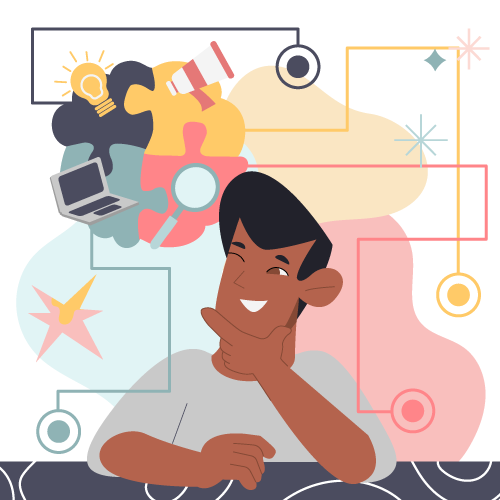Imagine a training session where learners are eager to participate—asking questions, exchanging ideas, and fully immersed in the material. This level of interaction isn’t just ideal; it’s a sign of strong learner engagement. However, many trainers and instructional designers struggle with disengaged learners who passively absorb content without retaining or applying it effectively. Understanding what drives engagement is key to designing impactful learning experiences. In this guide, we’ll explore what learner engagement is, why it matters, and proven strategies to foster active participation and long-term knowledge retention.
What is learner engagement? Learner engagement refers to the level of attention, participation, and motivation a learner demonstrates during training. Engaged learners actively interact with content, retain information better, and apply their knowledge effectively. Discover strategies to boost engagement and create impactful learning experiences.
Why engagement matters in learning
Think of a learner’s mind as a vast, unexplored landscape. Passive lectures deposit nuggets of information here and there, like dropping seeds on barren ground. Some seeds may sprout by luck, but most will fail to take root.
Now, envision an engaged learning environment: a vibrant ecosystem where learners actively explore, make connections, and cultivate knowledge. Transforming the barren landscape into a fertile garden is similar to carefully planting seeds, nurturing them, and watching them blossom into a flourishing crop of understanding.
The science of learning overwhelmingly supports the notion that engagement is the key to unlocking a learner’s full potential. Here’s why.
Enhanced learning outcomes
Research shows that a highly engaged learner retains information better and for longer. Active participation strengthens neural pathways, solidifying knowledge and fostering deeper understanding.
When actively involved, we process information more thoroughly, connect to existing knowledge, and create a stronger memory trace. It translates into higher test scores and, even more significantly, the capacity to utilize knowledge in practical scenarios.
Increased motivation
Disengaged learners are often passive recipients of information, leading to boredom and a lack of intrinsic motivation. Engagement, however, fuels the fire of curiosity. It sparks a desire to explore, ask questions, and delve deeper into the material.
Intrinsic motivation can be a powerful force for learning, as it empowers learners to take control of their education and actively pursue knowledge.
Greater enjoyment of the process
Learning shouldn’t feel like a chore. Engagement transforms the learning experience from a forced march into an exciting adventure. Interactive activities, collaborative tasks, and a sense of accomplishment create a positive learning environment.
Fostering a love of learning that extends beyond the classroom or training session sets learners on a lifelong journey of discovery.
Investing in learner engagement isn’t just about ticking a box. It’s about harnessing the power of the human brain to create a truly transformative learning experience. By prioritizing engagement, we tap into the science of learning to cultivate a fertile ground where knowledge can flourish.
Strategies for increasing learner engagement
The good news is that fostering learner engagement doesn’t require a complete overhaul of your educational approach. By incorporating a few key strategies, you can transform your learning environment into a dynamic hub for active participation and knowledge acquisition.
Here are six powerful strategies to keep learners engaged with learning:
Interactive learning methods
Inject excitement into your learning sessions by replacing passive lectures with interactive methods. These techniques transform learners from sponges absorbing information to active participants, fostering a deeper understanding and a more engaging relationship with the material.
- Gamification: Use points, badges, and leaderboards to motivate learners, fuel competition, and celebrate achievements. Incorporate challenges, unlock new content based on progress, or reward learners with virtual redeemable within the platform.
- Interactive simulations: Immerse learners in real-world scenarios with simulations. Learners can apply knowledge in a safe, virtual environment, make decisions, and experience the consequences.
- Scenario-based learning: Challenge learners with “what if” situations to apply knowledge and develop critical thinking skills. Branching narratives with choices and outcomes promote active participation and knowledge adaptation.
These techniques can also be used if you’re creating a mobile learning ecosystem. The secret of keeping learners engaged with mobile learning is incorporating interactive methods. Mobile platforms can incentivize participation and foster a sense of accomplishment by gamifying learning experiences with points, badges, and leaderboards.
Microlearning
Our attention spans are shrinking, and learning needs to adapt. Microlearning uses bite-sized nuggets of information for short bursts of learning throughout the day. This approach caters to busy learners who can access microlearning modules on their smartphones or tablets, eliminating the overwhelm of lengthy lectures.
Microlearning can be a powerful tool, but it’s important to use it strategically. To design compelling microlearning experiences, focus on a single, well-defined learning objective in each module.
To prevent information overload for learners, ensure they fully understand by incorporating various elements like short videos, interactive quizzes, infographics, or micro-podcasts to keep them engaged.
Embrace the power of multimedia
People learn best in different ways. Move beyond text-heavy content and incorporate multimedia elements like graphics, images, diagrams, lectures, podcasts, activities, simulations, and role-playing exercises.
The content is designed to accommodate different learning styles, including visual, auditory, and kinesthetic. By ensuring effective engagement with the material, everyone can retain the information.
Related: Multimedia in eLearning
Social and collaborative learning
Learning shouldn’t be a solitary journey. Collaboration and social learning tap into our natural desire to connect and share ideas, fostering a richer and more engaging experience.
- Group discussions and activities: Facilitate group discussions, debates, and problem-solving activities. Encourage learners to share perspectives, build upon each other’s ideas, and develop critical thinking skills.
- Online forums and communities: Create online forums or communities where learners can discuss topics, ask questions, and share resources with each other. Fostering a sense of community and providing the opportunity for learners to learn from each other outside of formal sessions is beneficial.
By promoting social and collaborative learning, you create a dynamic environment where learners not only gain knowledge but also develop valuable communication and teamwork skills, essential for success in today’s world.
Track progress and provide feedback
The learning journey isn’t complete once the content is delivered. It’s essential to monitor learner progress, offer reinforcement feedback, and assess comprehension.
Use your learning management system to monitor progress and help identify areas where learners may struggle, including:
- Module completion
- Assessment scores
- Activity participation
Offer timely and constructive feedback on learner performance. Feedback can take various forms, such as written comments, automated responses to quizzes, or one-on-one coaching sessions.
Nurture a learner-centered environment
Transition from an instructor-driven approach to one that prioritizes the learner. Placing learners at the core enhances engagement and enriches the learning experience. Consider the following strategies:
- Engage learner input: Gather feedback from learners consistently throughout their journey. Utilize surveys, discussions, or informal check-ins to grasp their needs, preferences, and any obstacles they encounter.
- Empower learner autonomy: Encourage learners to assume responsibility for their learning process. Provide opportunities for them to set goals, select learning paths, and delve into topics of personal interest.
- Recognize learner achievements: Celebrate both major milestones and smaller victories attained by learners.
Personalization and learner autonomy
Adult learners come to the table with a wealth of experience and diverse learning goals. When training Gen Z, Millennials, improving engagement, etc. a one-size-fits-all approach simply doesn’t work. Personalization and learner autonomy are key strategies to increase engagement and cater to individual needs.
Personalization tailors the learning experience to the specific role, goals, and preferences of each learner. Imagine a project manager who needs to brush up on communication skills, but a salesperson who might require in-depth product knowledge. A personalized learning path would deliver relevant content and activities for each learner, maximizing their engagement and learning outcomes.
Learner autonomy, on the other hand, empowers learners to take charge of their learning journey. This goes beyond simply choosing a learning path. It encompasses features like:
- Self-paced learning: Learners can progress through the material at their own pace, revisiting sections as needed.
- Choice of learning format: Provide options like videos, articles, or interactive simulations to cater to different learning styles.
- Goal setting: Allow learners to set personal learning goals and track their progress towards achieving them.
While personalized learning tailors the learning experience to the individual, adaptive learning takes personalization a step further.
Adaptive learning technologies use algorithms to assess learner strengths and weaknesses, then adjust the difficulty level of content and suggest relevant learning resources.
While adaptive learning is often associated with K–12 education, the core principles can be applied to adult learning as well. For corporate Learning and Development (L&D) programs, pre-assessments can be used to gauge existing knowledge and tailor learning paths to address specific skill gaps within a particular role.
Here are some additional points to consider:
- Focus on role-specific examples: Adult learners appreciate real-world scenarios and examples that directly apply to their work.
- Offer curated resources: Instead of overwhelming learners with endless options, provide a well-chosen selection of high-quality resources aligned with their learning goals.
- Don’t lock navigation: Adult learners value autonomy. Allow them to navigate freely through the learning materials and give them control over their learning journey.
Personalized learning, compared to adaptive learning, offers different approaches to tailoring the learning experience.
Personalized learning focuses on aligning content, activities, and resources with the specific needs and goals of each learner. Adaptive learning, on the other hand, leverages technology to dynamically adjust the learning path based on a learner’s performance and progress.
LXD and the types of learner engagement
Engaging learners is at the core of successful learning experience design (LXD). By understanding the various types of learner engagement, we can tailor our approach to maximize participation and knowledge retention.
Here are some key types of learner engagement, along with LXD techniques known to enhance them:
- Cognitive engagement: This involves active mental processes such as attention, analysis, and problem-solving.
- Scenario-based learning: Immersing learners in realistic scenarios challenges their critical thinking skills and promotes active engagement.
- Interactive quizzes: Incorporating quizzes and assessments encourages learners to apply their knowledge and reinforces learning objectives.
- Behavioral engagement: This refers to the observable actions and interactions of learners within the learning environment.
- Discussion forums: Providing opportunities for learners to engage in discussions fosters collaboration and community building.
- Peer learning activities: Pairing learners for collaborative projects or peer review activities promotes active participation and social interaction.
- Emotional engagement: This involves the learner’s feelings, motivations, and attitudes towards the learning experience.
- Personalized feedback: Offering individualized feedback acknowledges learners’ efforts and reinforces positive behavior.
- Storytelling: Incorporating narratives and real-life examples resonates with learners on an emotional level, making the content more relatable and memorable.
Assessing engagement in learning programs
Ensuring your carefully crafted learning experiences hit the mark requires measuring learner engagement. This allows you to identify areas for improvement and celebrate successes. Here are some valuable tools:
- Learner surveys: Gather feedback through surveys at key points in the program. Ask about content clarity, instructor effectiveness, and overall satisfaction.
- Observational assessments: Monitor learner behavior during the program. High levels of participation, active discussions, and completion rates are positive indicators of engagement.
- Learning management system (LMS) data: Utilize your LMS to track learner progress, completion rates, and time spent on modules.
By implementing a combination of these techniques, you can gain valuable insights into learner engagement, identify areas for improvement, and ensure your learning programs deliver a truly impactful experience.
Turn Engagement Into Action
Fostering learner engagement isn’t just possible—it’s essential for effective training. By incorporating interactive methods, microlearning, multimedia content, social collaboration, and personalized learning, organizations can create dynamic learning experiences that captivate learners and drive real results. But implementing the right strategies requires expertise and the right tools.
Ready to transform your training programs? Contact us to explore our innovative learning solutions and discover how we can help you design training that keeps learners engaged and empowered.





